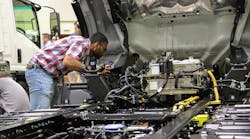SANDUSKY, Ohio—With so many ways out there to upfit a work truck, designing a chassis that can house all of them has been a challenge for OEMs. On the same platform, a utility may want to put a crane on the back, while a municipal fleet needs a snowplow upfront. The near-limitless amount of possible variations can force the OEMs to tweak designs when they discover their vocational chassis can’t accommodate certain upfits.
To make future chassis more universal, NTEA – The Work Truck Association has released The OEM Chassis Considerations Guide. The guide is free to NTEA members and serves as a cheat sheet to help OEMs get the design right the first time.
See also: Mission critical: Successful spec’ing
The book is an evolved form of NTEA’s Chassis Design Considerations for the Service Body Industry, and will serve as a much-needed tool to help engineers keep up with growing complexity and combat the “knowledge gap,” according to Steve Spata, NTEA senior technical assistance director, who spoke to Fleet Maintenance at the NTEA Upfitters.
“OEMs have been losing a lot of experience like everybody else,” Spata explained. “[The OEM Chassis Considerations Guide is] a way to take out some of the steepness of the learning curve for OEM product development people and product planners. That makes [the upfitting process] easier, makes it cost less and much more smooth, and gets the fleet customer the right vehicle.”
Spata noted that on the upfitter side, the guidance will lead to more purpose-built chassis that offer ample space for vocational components, while removing the need for upfitters to “hack into wiring.”
The guide covers:
- Chassis features and functions
- Electrical needs
- Regulatory and safety considerations
- Vocational market and design challenges
It also offers strategic recommendations and considerations for key industry segments, including:
- Ambulances
- Articulating cranes
- Cargo van interiors
- Dump bodies
- Mid-size buses
- Propane trucks
- Service bodies and telescopic cranes
- Snowplows
- Van bodies
This article originally appeared on Fleet Maintenance, a FleetOwner affiliate and Endeavor Business Media publication.




